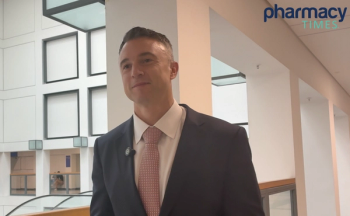
Pharmacy Practice in Focus: Oncology
- December 2023
- Volume 5
- Issue 8
Medication Adherence to BTK Inhibitors Can Pose Challenges for Patients With CLL
Although treatment is effective, AEs remain difficult for patients.
In 2022, more than 20,000 people received a diagnosis of chronic lymphocytic leukemia (CLL), a disease that can be characterized by the progressive accumulation of leukemic cells in peripheral blood bone marrow and lymphoid tissue, explained Desi Kotis, PharmD, vice dean of clinical affairs and chief pharmacy executive at the University of California, San Francisco School of Pharmacy, in a recent Pharmacy Times panel discussion. Kotis explained further that survival for patients with low-risk disease is 97% at 5 years and 80% at 10 years; for high-risk disease, the survival rate at 5 years decreases to 55% and 26% at 10 years.
During the discussion, panelists addressed common symptoms of patients with CLL, such as severe fatigue, heavy night sweats, extreme weight loss, and fever without infection. Additionally, panelists discussed the current treatment landscape for CLL and shared various strategies to improve patient education and adherence to medications, such as Bruton tyrosine kinase (BTK) inhibitors, which are a favored treatment for CLL.
Panelists explained that BTK inhibitors can be taken in the outpatient setting so patients are not faced with the burden of continuous laboratory tests in the clinic. This setting also provides more flexibility and more time away from the clinic, which can be a plus for the patient, explained Kate Berlin, PharmD, BCOP, a clinical pharmacist, leukemia and lymphoma, at Northwestern Medicine in Chicago, Illinois. They are also an oral treatment, which is a major upside, Kotis noted.
First-generation BTK inhibitor ibrutinib (Imbruvica; Pharmacyclics, Janssen Biotech) is a daily-dose BTK inhibitor shown to prolong survival compared with certain types of chemotherapy, explained Kotis. In clinical trials, it had more favorable tolerability than chemotherapy using chlorambucil.
There are 2 approved second-generation BTK inhibitors, acalabrutinib (Calquence; AstraZeneca Pharmaceuticals) and zanubrutinib (Brukinsa; BeiGene USA), which can be taken once or twice daily and could provide better tolerability than ibrutinib, said Kotis. Next-generation zanubrutinib appears to be favorable at reducing serious adverse events (AEs), as was observed in the SEQUOIA trial (NCT03336333), with prolonged progression-free survival at 85.5%, Kotis explained.
Yet the independence associated with BTK inhibitor administration can be a disadvantage. For Sandra Cuellar, PharmD, BCOP, a clinical associate professor and clinical oncology pharmacist with University of Illinois (UI) Health in Chicago, when she gives patients intravenous therapeutics, she sees the patient receive it and knows it is working. Because taking a BTK inhibitor is based on a patient’s own agency, they can choose to stop treatment for various reasons, even if it is not the end of the planned therapy duration.
Further, like most cancer drugs, BTK inhibitors are costly, explained Adam Robinson, PharmD, BCOP, a bone marrow transplant/clinical pharmacist with Northwestern Memorial Hospital in Chicago. Generally, many patients with CLL face cost-related roadblocks—especially given that many will be on treatment for a long time, Kotis said. There are affordability aids, such as a 1-month co-pay card, which can help patients get funding for temporary treatment while they wait for prior approval for the foundational medication; however, this is not available to all patients, such as those without insurance, noted Connor Roth, PharmD, BCOP, a hematology and oncology pharmacy specialist with Franciscan Health Olympia Fields in Olympia Fields, Illinois.
Thus, insurance, or lack thereof, becomes a part of the decision-making process for treatment, explained Roth. “There’s some hurdles there, and sometimes we do have to switch therapies [for this reason],” Roth said.
It’s also worth noting that there is a psychological toll of daily medication on quality of life, according to Berlin. “[We] as pharmacists may not consider the fact that taking a medication every single day [can be] a reminder of [their] diagnosis,” Berlin said. “It’s a constant reminder that it’s a chronic condition.”
Quality of life can also be affected by AEs associated with BTK inhibitors, such as neutropenia, anemia, thrombocytopenia, fatigue, rash, and headache, Kotis explained. Even influenzalike symptoms can have a patient saying, “I’m not going to take that drug ever again,” according to Daniel Przybylski, PharmD, BCOP, a hematology/oncology clinical pharmacist at Northwestern Memorial Hospital. For this reason, it remains important for pharmacists to communicate with patients about AEs and educate them on what may occur to improve quality of life and medication adherence, explained Mohammed Awad, PharmD, an oncology clinical pharmacist with Advocate Christ Medical Center in Oak Lawn, Illinois.
There are various ways that pharmacists can assess medication adherence for patients outside their presence in the pharmacy. For example, pharmacists can track appointment adherence, explained Talha Khan, PharmD, BCOP, a lead clinical hematology/ oncology pharmacist at Northwestern Memorial Hospital. The pharmacist can also evaluate refill rate, said Magdalena Dankowska, PharmD, BCOP, a hematology/oncology clinical pharmacist with Northwestern Memorial Hospital.
Pharmacists can also keep tabs on patient adherence to medications by making periodic phone calls, suggested Noor Naffakh, PharmD, a clinical assistant professor and a hematology and oncology clinical pharmacist with the University of Illinois Chicago (UIC) College of Pharmacy.
Przybylski explained that he maps personalized patient charts that include medications, dosages, timing, and scheduling. “[It] can be a little bit more tedious than it needs to be sometimes, but it’s very helpful for the patients,” said Przybylski.
Further, educating the patient is a good way to help them better understand comorbidities and other complexities associated with the diagnosis. Naffakh said that her hospital system aims to educate patients based on the best learning strategy for the individual. “For a lot of our older adults…we give them handouts. We try to do calendars [and] pillboxes, [and] go through their medications with them,” Naffakh explained.
Of the various strategies that can improve patient understanding of treatment options and clinical aspects of the disease, many panelists agreed that patients are becoming more inclined toward visual and auditory materials.
Visual aids like educational YouTube videos can be shared with patients via a simple link, and that reference can then be used whenever it is needed, Dankowska said. Christina Haaf, PharmD, BCOP, a clinical pharmacist and clinical assistant professor with UIC College of Pharmacy, also noted that she provides handouts for patients, but she still finds that they might need to ask her questions and hear her explain things verbally.
“I just feel like we have all this printed material and subscript language, and it checks all the boxes, but [some would] rather just watch a TikTok video about it,” said Cuellar.
Articles in this issue
almost 2 years ago
Palliative Care Is Not (Necessarily) the Endalmost 2 years ago
Exploring the Landscape of Gene TherapyNewsletter
Stay informed on drug updates, treatment guidelines, and pharmacy practice trends—subscribe to Pharmacy Times for weekly clinical insights.




















































































































































































































